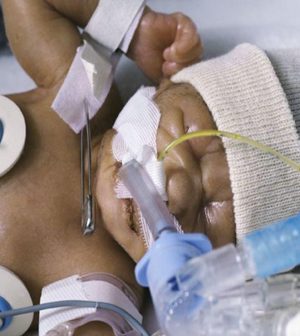- Navigating Your Midlife Crisis: Embracing New Possibilities
- City Raccoons Showing Signs of Domestication
- Mapping the Exposome: Science Broadens Focus to Environmental Disease Triggers
- One Week Less on Social Media Linked to Better Mental Health
- Your Brain Changes in Stages as You Age, Study Finds
- Some Suicide Victims Show No Typical Warning Signs, Study Finds
- ByHeart Formula Faces Lawsuits After Babies Sickened With Botulism
- Switch to Vegan Diet Could Cut Your Greenhouse Gas Emissions in Half
- Regular Bedtime Does Wonders for Blood Pressure
- Dining Alone Could Mean Worse Nutrition for Seniors
Skin-to-Skin Contact Could Boost Survival of Very Premature Babies

In a finding that demonstrates the power of a mother’s touch, new research shows that immediate and continuous skin-to-skin contact with mom reduces the risk of death for low-weight newborns in poorer nations.
“The idea of giving skin-to-skin contact immediately after delivery to very small, unstable babies has encountered quite strong resistance, but about 75% of deaths occur before the infant has been judged sufficiently stable,” noted study author Dr. Nils Bergman, of Sweden’s Karolinska Institute. Bergman, a researcher in the institute’s Department of Women’s and Children’s Health, spoke in an institute news release.
So, is separating a mom from her tiny newborn necessarily helping the infant?
To find out, the Swedish team looked at more than 3,200 infants with a birth weight of 2.2 to 3.9 pounds born at five university hospitals in Ghana, India, Malawi, Nigeria and Tanzania, where death rates for low-weight babies range between 20% and 30%.
Some infants received immediate and continuous skin-to-skin contact with their mother (immediate Kangaroo Mother Care — iKMC) in a neonatal unit where the mothers also received their medical care.
Meanwhile, a control group of infants received standard care, in which they and their mothers were cared for in separate units and only brought together for feedings.
As soon as the infants in both groups were sufficiently stabilized, they and their mothers were transferred to the regular KMC unit.
During the first 72 hours, the infants in the iKMC group received about 17 hours of skin-to-skin contact a day, compared with 1.5 hours in the control group.
In the first 28 days, death rates were 12% in the iKMC group and 15.7% in the control group, a 25% difference.
The researchers also found that significantly fewer babies in the iKMC group had low body temperature or bacterial blood poisoning, according to the study published May 26 in the New England Journal of Medicine.
The World Health Organization currently recommends that skin-to-skin contact begin as soon as a low-weight newborn is sufficiently stable, which for those weighing under 4.4 pounds at birth normally takes several days. But the agency is currently reviewing that guidance, the researchers noted.
“The main message is that low-weight newborns should receive skin-to-skin contact immediately after birth and subsequently at a mother-infant couplet care unit, where mothers and babies are looked after together without having to be separated,” study author Dr. Björn Westrup said in the release. “Our results suggest that this care model, which in itself isn’t resource-demanding, could have significant health effects.”
The study authors said iKMC has the potential to save the lives of an additional 150,000 small newborns each year.
More information
The March of Dimes has more on low birth weight.
SOURCE: Karolinska Institute, news release, May 26, 2021
Source: HealthDay
Copyright © 2025 HealthDay. All rights reserved.










